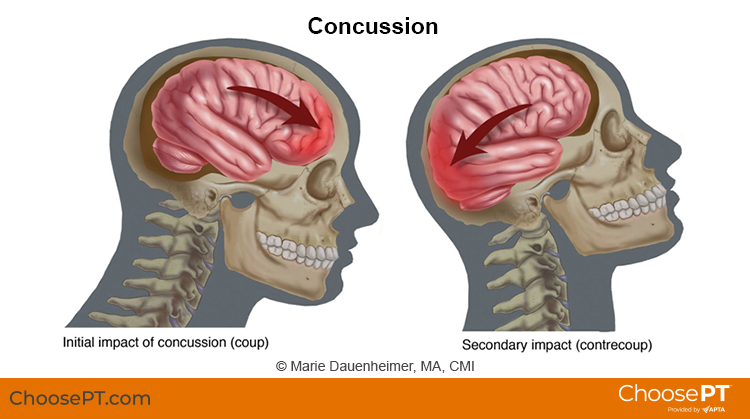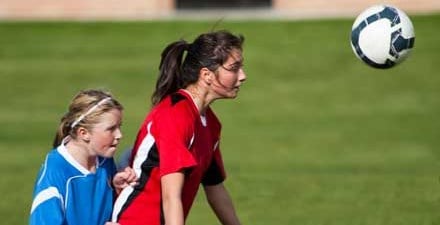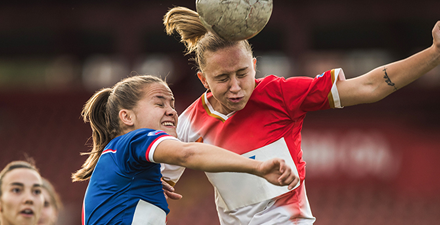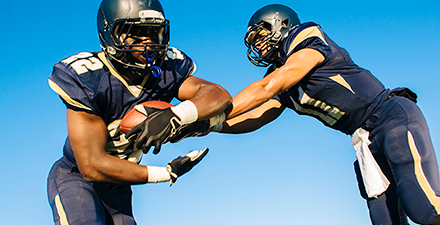Physical Therapy Guide to Concussion
A concussion is a mild traumatic brain injury. It can cause lasting effects on brain tissue and change the brain's chemical balance. Concussions may cause short-term and long-term physical (body), cognitive (thinking), and behavioral symptoms and problems. Every concussion is considered a serious injury by health care providers. If you have experienced a head injury, seek medical help immediately.
The Centers for Disease Control and Prevention estimates that 1.6 million to 3.8 million people experience concussions each year in the United States. Of these injuries, 1 million to 1.8 million occur during sports in youth under age 16. Nearly 50% of all concussions occur during sports and recreational activities; the other "half" (more than 50%) are due to falls. It is understood that as many as 50% of concussion injuries go undetected, especially among older adults and in cases with multiple injuries at once (such as car accidents and intimate-partner violence).
A concussion occurs when a force strikes the head or the body. Less than 10% of concussions include a loss of consciousness (being "knocked out"). A brief loss of consciousness (lasting two minutes or less) has no impact on the recovery path a patient will take. Symptoms can start immediately or take hours to a few days to appear. Knowing the warning signs can help people access care as quickly and efficiently as possible.
A physical therapist can assess symptoms to determine if a concussion is present. They can treat your injury by guiding you through a safe and personalized recovery program. Physical therapists are movement experts. They improve quality of life through hands-on care, patient education, and prescribed movement. You can contact a physical therapist directly for an evaluation. To find a physical therapist in your area, visit Find a PT.
What Is a Concussion?

A concussion is a brain injury that occurs when the brain rocks back and forth within the skull. The injury can happen during rapid movement changes (such as whiplash) or when the head is directly hit. This shaking or hitting of the head can cause unpredictable injury to any area of the brain. As a result, there can be immediate or delayed changes in the brain's chemistry and function. Depending on which area of the brain is affected, different temporary or permanent problems with brain function can occur.
Concussions can occur at any age from a variety of causes, including:
- Motor vehicle collisions (head impact, whiplash).
- Work accidents (falls, head trauma).
- Playground accidents (falling from a slide or swing).
- Sports injury to the body, head, or neck.
- Falls (which are the leading cause of concussions).
- Violent events, such as:
- Physical abuse, during which the head is struck or shaken.
- Being too close to a blast or explosion.
- A direct blow to the head, face, or neck.
- Assaults or intimate-partner violence.
Recovery from a concussion can take several weeks to months and sometimes years. Many factors can affect the length of recovery, including age and severity of the injury.
Concussions may occur along with other injuries. Any injury to the neck and surrounding tissues should be managed by a licensed physical therapist. More serious brain injuries — such as bruising, bleeding, or tearing — require the immediate care of a physician, such as a neurosurgeon.
Caution: Some concussions can lead to long-term brain damage. Seek medical help from a licensed health care provider following any head injury.
Signs and Symptoms
There are many symptoms related to concussion. Symptoms can affect your physical, emotional, and mental well-being. Some symptoms occur immediately; some occur a few hours after the injury. Other symptoms can build for months or years after a concussion.
It is important to seek medical treatment immediately following any head injury. The risk of death or permanent brain damage from a concussion can be minimized by immediate and appropriate treatment from health care providers like a physical therapist. Only health care providers have the knowledge and training to identify concussion in the maze of symptoms that can occur following a head injury.
Physical symptoms of a concussion can include:
- Headache.*
- Dizziness.*
- Problems with balance and coordination.*
- Nausea and vomiting.
- Fatigue.
- Trouble sleeping.
- Increased sleepiness.
- Double or blurred vision.*
- Sensitivity to light and sound.
- Slurred speech.
- Glassy-eyed stare.
- Seizures.
*These symptoms are the most common after a concussion. They also have the greatest ability to predict a longer recovery lasting more than three weeks. It is important to seek early care if you have any of these symptoms after a concussion.
Cognitive (thinking) symptoms can include:
- Difficulty with short-term or long-term memory.
- Confusion.
- Slowed "processing" (such as a decreased ability to think through problems).
- "Fogginess."
- Difficulty concentrating.
- Worsening grades in school.
Emotional symptoms can include:
- Irritability.
- Restlessness.
- Anxiety.
- Depression.
- Mood swings.
- Aggression.
- Decreased tolerance of stress.
- Change in personality or behavior.
Longer-term symptoms may include:
- Chronic headaches.
- Chronic dizziness.
- Fatigue.
- Exercise intolerance or reduced exercise ability.
- Changes in heart rate and/or blood pressure.
- Muscle weakness.
- Muscle spasticity.
- Loss of libido.
- Loss of menstruation (menses).
- Growth problems in children.
- Weight gain.
- Early dementia or chronic traumatic encephalopathy (brain disorder).
In some cases, concussion symptoms do not go away in the expected time frame. The term for these continuing symptoms is persistent post-concussion syndrome and is reserved for patients with symptoms lasting for more than three weeks after injury. These symptoms need further testing and treatment by a team of health care providers, including a physical therapist.
Post-concussion syndrome is the term that describes symptoms, such as headaches or dizziness, that persist for weeks or months after the initial injury.
Second-impact syndrome
is a serious, yet preventable, complication that can occur after a concussion. If a person who has suffered a recent concussion experiences another concussion, permanent brain damage or death can occur. Permanent brain damage can include:
- Learning disabilities.
- Personality changes.
- Walking disability.
- Other brain or nerve disabilities.
With improved awareness, cases of second-impact syndrome have been greatly reduced. An example of second-impact syndrome would be a football player who suffers a concussion in a game but keeps playing and is hit again, causing the brain to swell rapidly inside the skull. Another example is the person who suffers a concussion from whiplash in a car crash and then falls at home and endures another concussion very soon after the initial injury.
Extreme care should be taken after a concussion to prevent a second injury.
Athletes who suffer a concussion during practice or competition must be removed immediately from play to prevent subsequent concussions and second-impact syndrome. Research shows that athletes who continued to play after a concussion required twice as long to return to play. Any team’s physical therapist will advise that "it is better to miss a single game than the whole season." A physical therapist will work to develop safe guidelines for return to play, return to work, and return to life's daily requirements.
A longer recovery time may be required for those with a history of the following problems:
- Prior concussions.
- Eye tracking or movement issues from childhood.
- Motion sickness or motion intolerance.
- Migraines.
- Attention deficit hyperactivity disorder.
- A learning disability.
It's important to discuss your entire medical health history with your physical therapist.
How Is It Diagnosed?
Concussion is most often diagnosed through careful testing by your health care provider, such as a physical therapist. Unfortunately, no single test or tool exists to diagnose a concussion. The diagnosis usually does not rely on hi-tech testing, such as an MRI or CT scan, because brain scans often do not show any abnormality, even when the person has symptoms of a concussion.
There are four physical domains (areas) of concussion, including:
- The neck.
- Body control and balance.
- The eyes and inner-ear systems.
- Exercise systems.
A thorough examination should screen for any challenges in these four areas.
Your physical therapist will ask you many questions to understand all the symptoms that you are experiencing. They also will perform numerous tests to identify problems caused by a concussion, including tests of your:
- Muscle strength.
- Coordination.
- Balance.
- Sight.
- Hearing.
- Head motion tolerance.
- Memory tests.
During treatment, your physical therapist will repeat the same questions and tests often to gauge your progress. Doing so will also enable them to judge when you can return to work, school, sport, or recreational activities.
If you are an athlete who underwent a preseason concussion baseline test, your physical therapist may work with the health care provider who performed that testing. They can compare your baseline and their current findings to help determine if you have a concussion and assist with return to sport or activity clearance.
Your physical therapist may also examine your neck for problems following a concussion. Neck injuries can occur at the same time as concussions and can cause or increase headaches and dizziness.
How Can a Physical Therapist Help?
Physical therapists can evaluate and treat many problems related to concussions. Because no two concussions are the same, a physical therapist will examine your neurological, orthopedic, and cardiovascular systems to best prescribe a routine to address your specific symptoms and needs.
Treatment may include:
Rest and recovery. Complete rest after a concussion should last for no longer than 48 to 72 hours. Your brain requires a balance of activity and rest to heal properly. Your physical therapist will help you and your family understand why you should limit any activity (daily tasks, work, school, sports, recreation, the use of electronics) after a concussion until it is safe to return to them. Alternating activity with periods of rest (pacing your recovery) can safely challenge the brain and help symptoms clear up as quickly as possible. Your physical therapist will prescribe the rest and recovery program most appropriate for your condition. A good rule of thumb is to stop any activity when your symptoms increase by 30% and rest until you recover from that activity before starting again.
Restoring strength and endurance. The physical and mental rest required after a concussion can result in muscle weakness and a decrease in physical endurance. Complete rest should not occur for more than 48 to 72 hours in most circumstances. Your physical therapist can help you regain your strength and endurance when the right time comes without making your concussion symptoms worse. It is important to improve your tolerance to cardiovascular exercise (such as walking or biking) before starting heavy strength training to allow for proper blood flow to your brain. It is common for weekend warriors, elite-level athletes, and everyone in-between to experience exercise intolerance with concussion and brain injury. Your physical therapist will work with you to identify and treat your particular concussion symptoms. They can help you build back to — or up to — doing 150 minutes of moderate-intensity cardiovascular exercise per week. This is the minimum amount recommended by the Department of Health and Human Services for overall health.
Your physical therapist will design a therapeutic exercise program just for you. They will closely monitor your symptoms as you participate in the program.
Stopping dizziness and improving balance. If you have dizziness or difficulty with your balance, you are not alone. Dizziness and balance problems are the top complaints after a concussion. A type of physical therapy called vestibular physical therapy may help. The vestibular system, which includes the inner ear and its connections with the brain, helps you keep your balance and prevent dizziness. A qualified vestibular physical therapist may be able to help reduce or stop your dizziness or balance problems after a concussion by applying special treatments or teaching you specific exercises, some of which you may be able to do at home.
Improving vision. Vision challenges are common after a concussion. A full 50% to 90% of concussion patients experience challenges with their eyes, inner-ear systems, or both. The visual system is more complicated than just seeing clearly. It involves the muscles that control the eyes and the network in your brain that allows you to assign meaning and interpret what you see as you interact with the world. Skilled health care providers, including physical therapists, can help you:
- Reorganize your vision.
- Improve your tolerance to reading and to using electronic screens.
- Reduce headaches and dizziness coming from the eyes.
Reducing headaches. Your physical therapist will assess the possible causes of your headaches. They will use specific treatments and exercises to reduce and eliminate them. Treatment may include stretches, strength and motion exercises, eye exercises, and hands-on techniques like specialized massage. Your physical therapist also may use technologies such as electrical stimulation.
Returning to normal activity or sport. The number one evidence-backed treatment for concussion is early, symptom-guided, and paced progressive exercise. Cardiovascular exercise is an early priority, with the treatment program building into strength and dynamic (sports-specific) exercises as your symptoms allow. As your conditioning and strength improve, your physical therapist will help you gradually add back normal activities to your daily routine. Your physical therapist will help you avoid overloading your brain and nervous system as you increase your activity level. Overloading your brain during activity after a concussion interferes with the healing of the brain tissue. This can make your symptoms return. Your physical therapist will help you return to your normal life and sports activities in the quickest and safest way possible, while allowing your brain to properly heal.
Can This Injury or Condition Be Prevented?
While initial injuries can't always be prevented, it is very important to prevent further injuries to those with concussions. The injured person should be protected until all symptoms have cleared and normal activity can resume.
Following the recommendations above, including early symptom-guided exercise and pacing strategies, can help keep a concussion from lasting longer than necessary. With the right education and strategies provided early, most sports concussions will heal within a few weeks. It is important to be cautious as you transition back to sports or higher-risk activity. There is recent evidence of increased risk of upper body injuries (2.36 times greater risk) and lower body injuries (2.5-3.4 times greater risk) after concussion in the same sports season. Ensuring a full recovery and proper supervision can help reduce these added health risks.
The risk of concussion or repeat injury can be greatly reduced by taking the following precautions:
- Avoid motor vehicle collisions and practice safe driving habits, including:
- Always wear your seatbelt.
- Drive defensively, not aggressively.
- Eliminate distractions while driving, such as eating, talking on a cell phone, or texting.
- Choose cars with airbags.
- Make sure your car's airbags are in good working order.
- Avoid risky behavior in sports:
- Always wear a helmet.
- Absolutely avoid football techniques that increase the risk of concussion, such as "spearing" and headbutting.
- Avoid or limit "heading" the ball in soccer. U.S. Soccer has regulations preventing children under age 10 from heading the ball during practice or games. Children 11 to 13 years old also have some limited exposure restrictions.
- Don't ignore or hide signs of concussion, even for an important game or competition. Athletes should report symptoms to their coach immediately.
- Know that neither helmets nor mouth guards prevent concussions. They do, however, help to reduce the risk of more severe head injuries.
- Clear your walking areas at home of any objects that might increase the risk of a fall, such as loose throw rugs, dropped objects, loose flooring, torn or rumpled carpets, and pet toys or dishes.
- Make sure that all traffic areas in your home are well lit.
- Avoid exposure to blast explosions and violent events.
- Do not shake babies or anyone of any age!
It is imperative to prevent second-impact syndrome after an initial concussion. The injured person should be protected until all symptoms have cleared and normal activity can resume.
What Kind of Physical Therapist Do I Need?
All physical therapists are prepared through education and experience to treat a variety of conditions or injuries. You may want to consider:
- A physical therapist who is experienced in treating people with concussions or post-concussion problems. Some physical therapists have a practice with a neurological or vestibular rehabilitation focus.
- A physical therapist who is a board-certified clinical specialist or who completed a residency or fellowship in neurologic physical therapy. This physical therapist has advanced knowledge, experience, and skills that may apply to your condition.
You can find physical therapists who have these and other credentials by using Find a PT, the online tool built by the American Physical Therapy Association to help you search for physical therapists with specific clinical expertise in your geographic area.
General tips when you're looking for a physical therapist (or any other health care provider):
- Get recommendations from family, friends, or other health care providers.
- When you contact a physical therapy clinic for an appointment, ask about the physical therapists' experience in helping people with concussion.
- Be prepared to describe your symptoms in as much detail as possible and say what makes your symptoms worse.
The American Physical Therapy Association believes that consumers should have access to information that can:
- Help them make health care decisions.
- Prepare them for a visit with their health care provider.
The following articles provide some of the best scientific evidence for the treatment of concussion. The articles report recent research and give an overview of the standards of practice in the United States and internationally. The article titles link either to a PubMed* abstract of the article or to the free full text to read or bring with you to your health care provider.
Centers for Disease Control and Prevention. Heads Up. Published 2015. Accessed August 22, 2024. https://www.cdc.gov/heads-up/index.html
Leddy JJ, Burma JS, Toomey CM, et al. Rest and exercise early after sport-related concussion: a systematic review and meta-analysis. Br J Sports Med. 2023;57:762–770. Article Summary on PubMed.
Patricios JS, Schneider KJ, Dvorak J, et al. Consensus statement on concussion in sport: the 6th International Conference on Concussion in Sport–Amsterdam, October 2022. Br J Sports Med. 2023;57:695–711. Article Summary on PubMed.
Karmali S, Beaton MD, Babul S. Outlining the invisible: experiences and perspectives regarding concussion recovery, return-to-work, and resource gaps. Int J Environ Res Public Health. 2022;19:8204. Article Summary on PubMed.
Herring S, Kibler WB, Putukian M, et al. Selected issues in sport-related concussion (SRC|mild traumatic brain injury) for the team physician: a consensus statement. British Journal of Sports Medicine. 2021;55(22):1251–1261. Article Summary on PubMed.
Ettenhofer ML, Remigio-Baker RA, Bailie JM, et al. Best practices for progressive return to activity after concussion: lessons learned from a prospective study of US military service members. Neurotrauma Reports. 2020;1:137–145. Article Summary on PubMed.
Quatman-Yates CC, Hunter-Giordano A, Shimamura KK, et al. Physical therapy evaluation and treatment after concussion/mild traumatic brain injury. J Orthop Sports Phys Ther. 2020;50:CPG1–CPG73. Article Summary on PubMed.
Schneider KJ, Leddy JJ, Guskiewicz KM, et al. Rest and treatment/rehabilitation following sport-related concussion: a systematic review. Br J Sports Med. 2017;51:930–934. Article Summary on PubMed.
*PubMed is a free online resource developed by the National Center for Biotechnology Information. PubMed contains millions of citations to biomedical literature, including citations in the National Library of Medicine's MEDLINE database.
Expert Review:
Aug 27, 2024
Revised:
Oct 7, 2024
Content Type: Guide
Concussion
PT, board-certified clinical specialist in neurologic physical therapy
Lauren Ziaks
PT, DPT, ATC, board-certified clinical specialist in neurologic physical therapy
You Might Also Like...
Health Tips
Recognizing Signs of a ConcussionMar 13, 2024
A concussion is a mild traumatic brain injury. Concussions can be caused by a bump, blow, or jolt to the head or body that causes the brain to move inside
Podcast
PT Overcomes Concussions, Designs Protocol For Mild Traumatic Brain InjuryFeb 20, 2020
Physical therapist Lauren Ziaks talks about the physical therapy treatment protocol she uses to help people get better after concussion.
Did You Know?
1 in 14 Kids Experience Significant Head InjuryMar 6, 2018
While much is reported on the devastating effects of head injuries among professional football players, new information reveals that children aged 3 to


